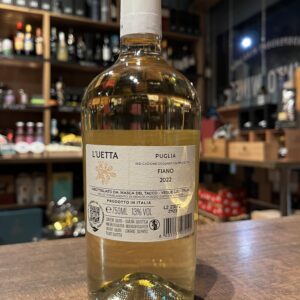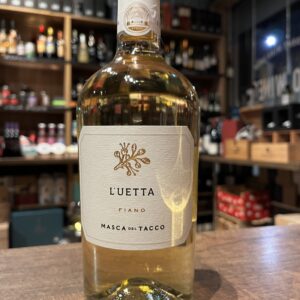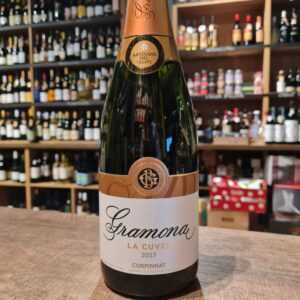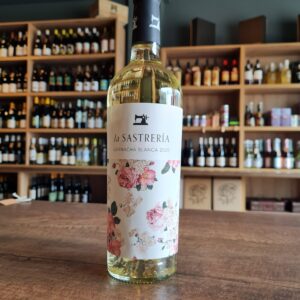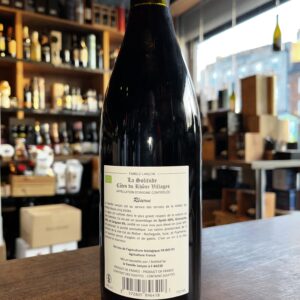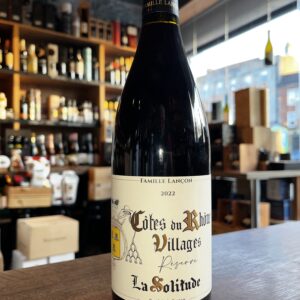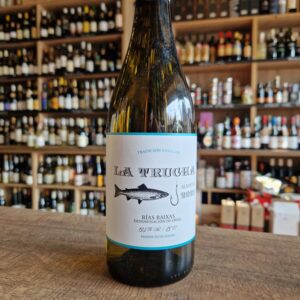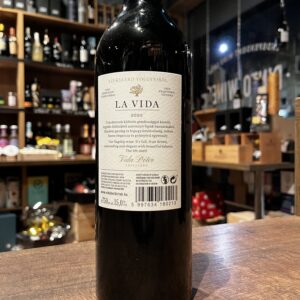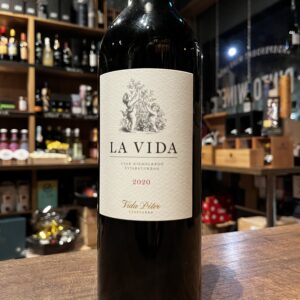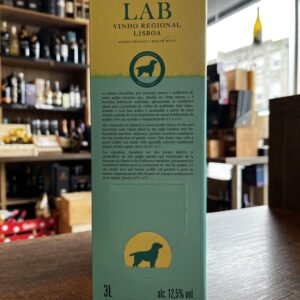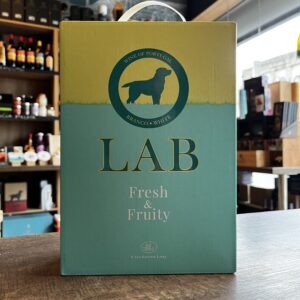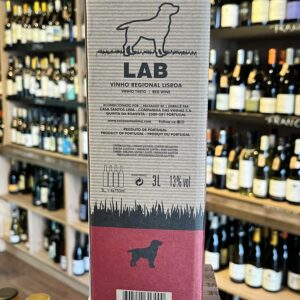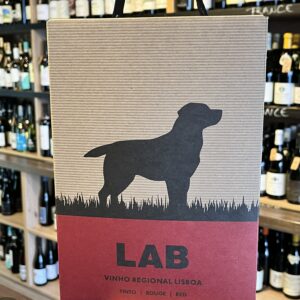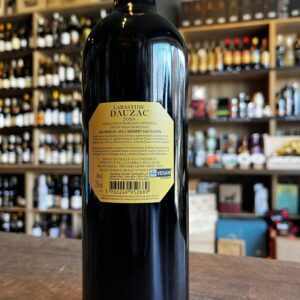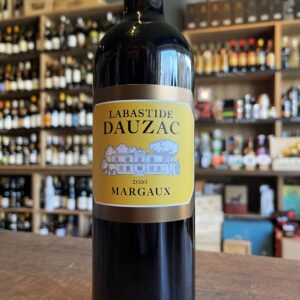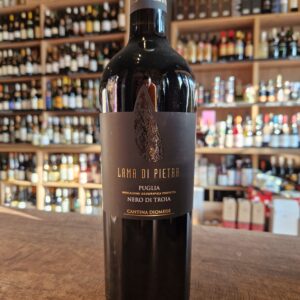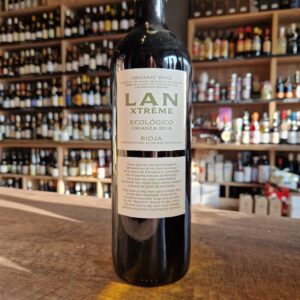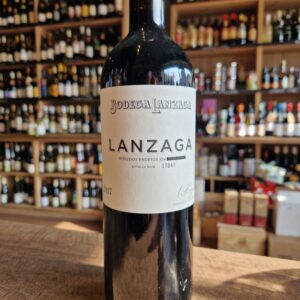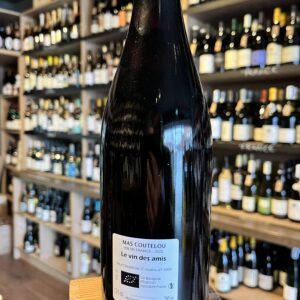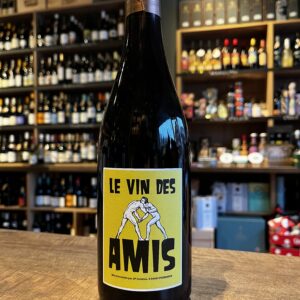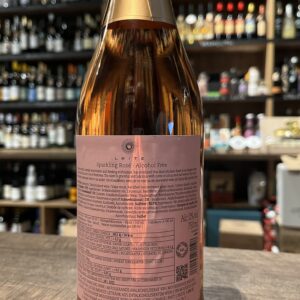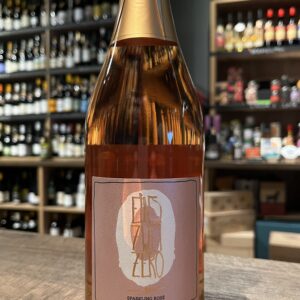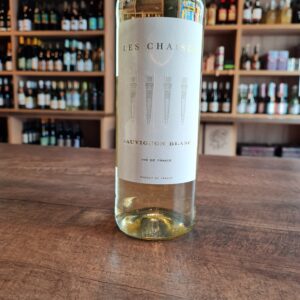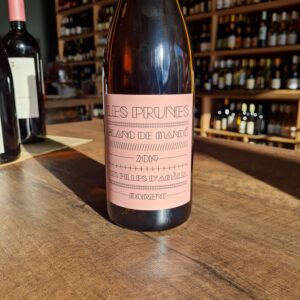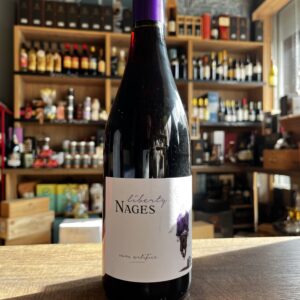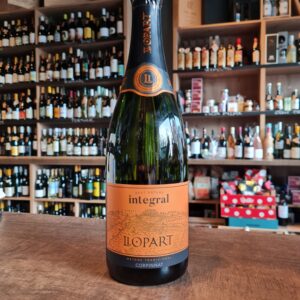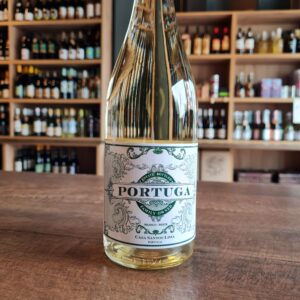-
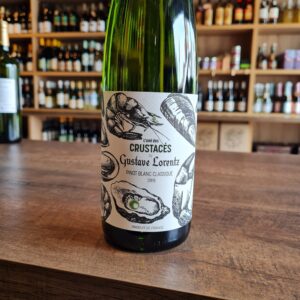 Produced by Gustave Lorentz, L'ami Des Crustacés 2018 is a well-priced Pinot Blanc from the Alsace Wine Region. Fresh and zesty on the nose with spiced pear and citrus aromas. Dry and crisp on the palate with white florals, spiced pear, ripe apple and peachy and citrus flavours. Finishes with a crisp, clean minerality. Great acidity for food. Chill and pair it with a pork schnitzel or breaded veal cutlets with a squeeze of lemon juice. Pork loin or grilled chicken, and as the name suggests any shelffish will match with it.
Produced by Gustave Lorentz, L'ami Des Crustacés 2018 is a well-priced Pinot Blanc from the Alsace Wine Region. Fresh and zesty on the nose with spiced pear and citrus aromas. Dry and crisp on the palate with white florals, spiced pear, ripe apple and peachy and citrus flavours. Finishes with a crisp, clean minerality. Great acidity for food. Chill and pair it with a pork schnitzel or breaded veal cutlets with a squeeze of lemon juice. Pork loin or grilled chicken, and as the name suggests any shelffish will match with it. -
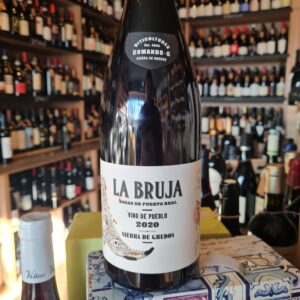 Daniel Landi and Fernando García have been friends since college. Successful winemakers in their own right – Dani at his family’s estate, Bodegas Jimenez-Landi and Fer at Bodega Marañones - in 2008 they started a winemaking project together: Comando G. Along with the pioneers of Priorat, Dani and Fer are redefining Garnacha, previously viewed as a workhorse variety, into something that can rival the elegance and finesse of Burgundian Pinot Noir or Syrah in the northern Rhône. The duo work with several small, isolated plots perched high up in the mountainous Sierra de Gredos to create truly unique, terroir-expressive wines. The vineyards that Daniel and Fernando have assembled are all farmed biodynamically, with vines ranging in age from 50 to 80 years old. According to Wine Advocate writer Luis Gutierrez, "they improve their vineyards from the moment they buy or rent them [...] The quality of their wines is what they strive to improve the most, and the results are there.” In the winery their winemaking is considered and precise, gently coaxing out the delicate balance of fruit character and terroir from each site. It is this commitment to a sense of place, nuance, and finesse that make their wines among the most compelling in Spain.
Daniel Landi and Fernando García have been friends since college. Successful winemakers in their own right – Dani at his family’s estate, Bodegas Jimenez-Landi and Fer at Bodega Marañones - in 2008 they started a winemaking project together: Comando G. Along with the pioneers of Priorat, Dani and Fer are redefining Garnacha, previously viewed as a workhorse variety, into something that can rival the elegance and finesse of Burgundian Pinot Noir or Syrah in the northern Rhône. The duo work with several small, isolated plots perched high up in the mountainous Sierra de Gredos to create truly unique, terroir-expressive wines. The vineyards that Daniel and Fernando have assembled are all farmed biodynamically, with vines ranging in age from 50 to 80 years old. According to Wine Advocate writer Luis Gutierrez, "they improve their vineyards from the moment they buy or rent them [...] The quality of their wines is what they strive to improve the most, and the results are there.” In the winery their winemaking is considered and precise, gently coaxing out the delicate balance of fruit character and terroir from each site. It is this commitment to a sense of place, nuance, and finesse that make their wines among the most compelling in Spain. -
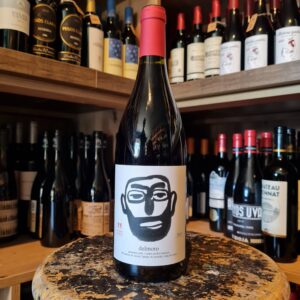 La Comarcal del Moro is part of a collaboration of two friends, Javi Revert and Victor Marqués, who first worked together at Celler del Roure. This wine comes from terroir specific vineyards to express the very best of the varieties they work with. Delmoro is predominantly Garnacha with some Bobal and Syrah in the blend, fermented separately, and aged in stainless steel and oak. All coming from a four hectare single vineyard. Rustic, but seductive, young but with some great lenght and complexity, this wine is not to be underestimated. Goes beautifully with poultry, pork and salmon.
La Comarcal del Moro is part of a collaboration of two friends, Javi Revert and Victor Marqués, who first worked together at Celler del Roure. This wine comes from terroir specific vineyards to express the very best of the varieties they work with. Delmoro is predominantly Garnacha with some Bobal and Syrah in the blend, fermented separately, and aged in stainless steel and oak. All coming from a four hectare single vineyard. Rustic, but seductive, young but with some great lenght and complexity, this wine is not to be underestimated. Goes beautifully with poultry, pork and salmon. -
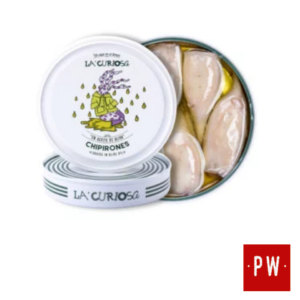 Squid have a delicate flavour and firm texture, which is achieved through rigorous selection control. Subsequently, it is washed, cooked and meticulously packed by their "canners".The se cephalopods are presented stuffed with their own legs and bathed in the best olive oil, resulting in an exquisite product.
Squid have a delicate flavour and firm texture, which is achieved through rigorous selection control. Subsequently, it is washed, cooked and meticulously packed by their "canners".The se cephalopods are presented stuffed with their own legs and bathed in the best olive oil, resulting in an exquisite product. -
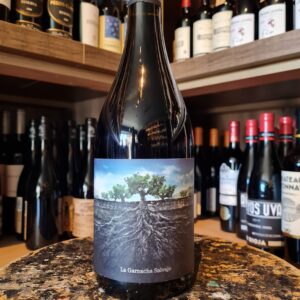 There's a lovely off the beaten track mountain wilderness (salvaje means wild) to this old-vine Garnacha (aka Grenache), one of six under the the creative Vintae's Proyecto Garnachas banner that showcase the grape variety from old vineyards in different areas of the Ebro Valley in northeast Spain. Like Gamay and Zinfandel, the old vines of Grenache are a timeless wonder. They are the Clint Eastwood of vitis vinifera: gnarled by age with a tough-as-nails exterior and no sign of retirement on the horizon. What they lack in quantity, they make up for in quality: grape clusters from old-vine Grenache (think 60-100 years old) can create wines of supple fruit, spicy character and rocket-fueled energy. This one is no exception, the Salvaje vineyards lie on rocky soils at 820m above sea level, on the north face of the Moncayo massif mountain chain, where Navarra and Aragón meet and the Atlantic influence brings mouthwatering freshness and clarity to the generous raspberry, wild herb and pepper flavours this wine induces. It doesn't need food, but it's very accommodating: spot on with roast peppers, aubergine, tomatoes and onions and with spicy sausages such as chorizo. It would be equally good with roast root vegetables, slow-roast lamb or pork, baked spiced duck legs or a ham joint and would make a good barbecue all-rounder.
There's a lovely off the beaten track mountain wilderness (salvaje means wild) to this old-vine Garnacha (aka Grenache), one of six under the the creative Vintae's Proyecto Garnachas banner that showcase the grape variety from old vineyards in different areas of the Ebro Valley in northeast Spain. Like Gamay and Zinfandel, the old vines of Grenache are a timeless wonder. They are the Clint Eastwood of vitis vinifera: gnarled by age with a tough-as-nails exterior and no sign of retirement on the horizon. What they lack in quantity, they make up for in quality: grape clusters from old-vine Grenache (think 60-100 years old) can create wines of supple fruit, spicy character and rocket-fueled energy. This one is no exception, the Salvaje vineyards lie on rocky soils at 820m above sea level, on the north face of the Moncayo massif mountain chain, where Navarra and Aragón meet and the Atlantic influence brings mouthwatering freshness and clarity to the generous raspberry, wild herb and pepper flavours this wine induces. It doesn't need food, but it's very accommodating: spot on with roast peppers, aubergine, tomatoes and onions and with spicy sausages such as chorizo. It would be equally good with roast root vegetables, slow-roast lamb or pork, baked spiced duck legs or a ham joint and would make a good barbecue all-rounder. -
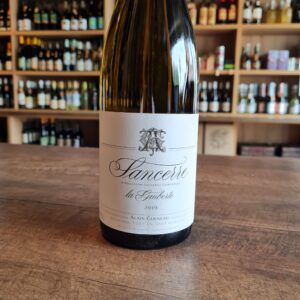 Stone fruit - check! Mineral - check! Floral - check! This wine is definitely ticking off all the right boxes! The minerality of saline and limestone sit on the tip of the tongue and linger through the entire taste. Light bodied, dry, moderate acidity, and a slightly exaggerated finish noted with blanched almonds and lemon rind bring the sip to an end. Time for another! An instant classic from a classic region! The Alain Gueneau Sancerre "La Guiberte" comes from a small family-owned estate at the Eastern end of France's Loire valley. You'll still find the grape's signature citrus freshness and a slight grassiness, but examples from Sancerre lean more towards restraint, minerality, and elegance. The secret is not only in Northern France's cooler climate, but also in the region's soil — a swathe of ancient clay-calcareous deposits that stretches from England's famous white cliffs of Dover across the channel and into Northern France. Alain and daughter Elisa are the 2nd and 3rd-generation of the Gueneau family to farm this land, three quarters of which is planted to Sauvignon Blanc vines with an average age of about 25 years. Enjoy this delicious, refreshing bottle (well chilled, of course!) now or over the next 3 years.
Stone fruit - check! Mineral - check! Floral - check! This wine is definitely ticking off all the right boxes! The minerality of saline and limestone sit on the tip of the tongue and linger through the entire taste. Light bodied, dry, moderate acidity, and a slightly exaggerated finish noted with blanched almonds and lemon rind bring the sip to an end. Time for another! An instant classic from a classic region! The Alain Gueneau Sancerre "La Guiberte" comes from a small family-owned estate at the Eastern end of France's Loire valley. You'll still find the grape's signature citrus freshness and a slight grassiness, but examples from Sancerre lean more towards restraint, minerality, and elegance. The secret is not only in Northern France's cooler climate, but also in the region's soil — a swathe of ancient clay-calcareous deposits that stretches from England's famous white cliffs of Dover across the channel and into Northern France. Alain and daughter Elisa are the 2nd and 3rd-generation of the Gueneau family to farm this land, three quarters of which is planted to Sauvignon Blanc vines with an average age of about 25 years. Enjoy this delicious, refreshing bottle (well chilled, of course!) now or over the next 3 years. -
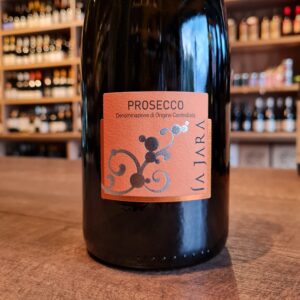 La Jara, based in the heart of Prosecco country just south of Conegliano, make a superb range of organic wines including some excellent Proseccos such as this. Being a frizzante it's got a soft sparkle and in some ways helps the fruit character stand out that bit more. With masses of fine bubbles and flavours of apple, peach, pear and ripe citrus fruits it's a very approachable style that's perhaps a bit too easy to drink. Certainly a step above a lot of other Proseccos. It's freshness makes it a great 'anytime' fizz. It's also really good alongside nibbles like olives, or tortilla chips and dips.
La Jara, based in the heart of Prosecco country just south of Conegliano, make a superb range of organic wines including some excellent Proseccos such as this. Being a frizzante it's got a soft sparkle and in some ways helps the fruit character stand out that bit more. With masses of fine bubbles and flavours of apple, peach, pear and ripe citrus fruits it's a very approachable style that's perhaps a bit too easy to drink. Certainly a step above a lot of other Proseccos. It's freshness makes it a great 'anytime' fizz. It's also really good alongside nibbles like olives, or tortilla chips and dips. -
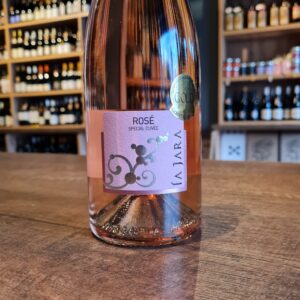 A totally irresistible semi-sparkling organic rosé from our favourite Prosecco producer La Jara, but in this case they use a little bit of the red grape Raboso, to give the wine its lovely pale coral colour. The nose is delicate and fruity, led by aromas of ripe strawberries and raspberries. The palate is fresh and tart, full of gooseberry and redcurrant notes. Try pairing this wine with risotto or pasta, or simply having it as an aperitif. Just for the fun of it, I leave you with a fun fact. The Italians call the string around the bottle a spago. It has no function other than that it looks nice. And that is exactly what makes it a real Italian wine. Beautiful on the inside and beautiful on the outside. A feast to watch and a feast to drink.
A totally irresistible semi-sparkling organic rosé from our favourite Prosecco producer La Jara, but in this case they use a little bit of the red grape Raboso, to give the wine its lovely pale coral colour. The nose is delicate and fruity, led by aromas of ripe strawberries and raspberries. The palate is fresh and tart, full of gooseberry and redcurrant notes. Try pairing this wine with risotto or pasta, or simply having it as an aperitif. Just for the fun of it, I leave you with a fun fact. The Italians call the string around the bottle a spago. It has no function other than that it looks nice. And that is exactly what makes it a real Italian wine. Beautiful on the inside and beautiful on the outside. A feast to watch and a feast to drink. -
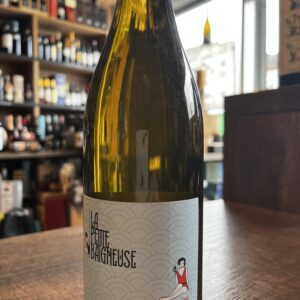 On the border between Roussillon and Corbières, in the heart of the Maury appellation, is the Domaine de la Petite Baigneuse . Philippe Wies, accompanied by his wife Céline, settled at the end of the 2000s, on the superb Maury shale terroirs, at an altitude of 350 meters with breathtaking views of the big blue sea. Surrounded by scrubland and protected by an environment of cliffs, the 14 hectares of vines benefit from a Mediterranean climate tempered by the wind and maritime inlets. Organic since the beginning of the adventure, the Petite Baigneuse estate also practices biodynamics and only works the soil very little. Some plowing is then carried out with a tractor and a tracker so as not to overturn the horizons. Not far from Calce's friends in the people of La Nouvelle Donne , and Domaine Jean-Philippe Padié , Philippe Wies is today an essential figure in the world of natural wines in the south of France. "Juste Ciel", a wine that calls for summer, fresh grilled fish, marinated supions, sea urchins, carpaccio de Saint Jacques.... In short, "La Petite Baigneuse" delivers here a wine to be enjoyed by the poolside with a Mediterranean meal thanks to its delicacy, its freshness and its notes of candied fruits. A very nice white wine to share with a nice meal.
On the border between Roussillon and Corbières, in the heart of the Maury appellation, is the Domaine de la Petite Baigneuse . Philippe Wies, accompanied by his wife Céline, settled at the end of the 2000s, on the superb Maury shale terroirs, at an altitude of 350 meters with breathtaking views of the big blue sea. Surrounded by scrubland and protected by an environment of cliffs, the 14 hectares of vines benefit from a Mediterranean climate tempered by the wind and maritime inlets. Organic since the beginning of the adventure, the Petite Baigneuse estate also practices biodynamics and only works the soil very little. Some plowing is then carried out with a tractor and a tracker so as not to overturn the horizons. Not far from Calce's friends in the people of La Nouvelle Donne , and Domaine Jean-Philippe Padié , Philippe Wies is today an essential figure in the world of natural wines in the south of France. "Juste Ciel", a wine that calls for summer, fresh grilled fish, marinated supions, sea urchins, carpaccio de Saint Jacques.... In short, "La Petite Baigneuse" delivers here a wine to be enjoyed by the poolside with a Mediterranean meal thanks to its delicacy, its freshness and its notes of candied fruits. A very nice white wine to share with a nice meal. -
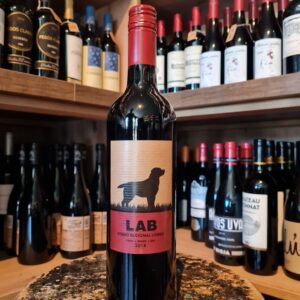 Lab tested and approved! This Lab is asking to be walked. Hitting all the puns here, only because that is exactly what you will get with this wine. It does what it says on the tin, if not more. This lovely red from Lisbon is full bodied but smooth and is very aromatic with notes of ripe black and red fruits. On the palate, juicy plums and dark berry fruit flavour with plenty of fresh yet fine tannins that take over at the finish, along with flavours of spice and liquorice. It is not top of the shelf but it does punch above its weight.
Lab tested and approved! This Lab is asking to be walked. Hitting all the puns here, only because that is exactly what you will get with this wine. It does what it says on the tin, if not more. This lovely red from Lisbon is full bodied but smooth and is very aromatic with notes of ripe black and red fruits. On the palate, juicy plums and dark berry fruit flavour with plenty of fresh yet fine tannins that take over at the finish, along with flavours of spice and liquorice. It is not top of the shelf but it does punch above its weight. -
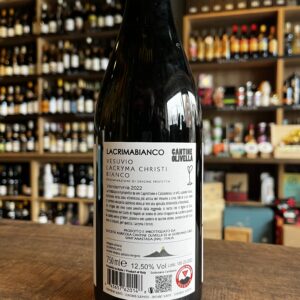
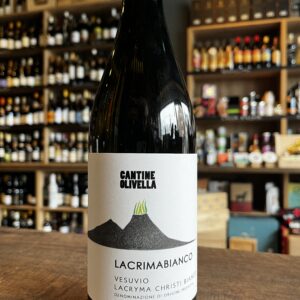 The native roots of the rare and unique grapes found in this ancient yet active volcano and the passion of local talent Andrea Cozzolino that was eager to breathe new life into one of Campania’s most historic wine regions would make Dionysus, god of the wine proud. Here on the slopes of Monte Summa Close to the ''Olivella'' Spring (where the winery takes its name), is the oldest part of Vesuvio (the volcano that destroyed Pompeii and continues to rumble, shaking the nerves of the Napolitani) grape growing is an ancient art, the lava-rich, sandy slopes of the volcano providing perfect terroir for native grapes such as Catalanesca and Piedirosso. In 1974, an ancient fragment of an earthenware wine jug was discovered. This is proof of the wealth of an area whose wines were some of the finest of ancient Rome on the market with Pompeii. An abbreviated inscription of “Sextus Catius Festus” is engraved on the opening of the earthenware jar along with a seal depicting a stylized leaf, similar to a heart. The seal tellingly became the logo for “Cantine Olivella”, and was modified into a wine glass. This is the perfect representation of the union between land, art and passion, namely three hearts beating in unison in the world of Cantine Olivella. Great served chilled as an appetiser or with fresh fish, shellfish; creamy fish soup or risotto
The native roots of the rare and unique grapes found in this ancient yet active volcano and the passion of local talent Andrea Cozzolino that was eager to breathe new life into one of Campania’s most historic wine regions would make Dionysus, god of the wine proud. Here on the slopes of Monte Summa Close to the ''Olivella'' Spring (where the winery takes its name), is the oldest part of Vesuvio (the volcano that destroyed Pompeii and continues to rumble, shaking the nerves of the Napolitani) grape growing is an ancient art, the lava-rich, sandy slopes of the volcano providing perfect terroir for native grapes such as Catalanesca and Piedirosso. In 1974, an ancient fragment of an earthenware wine jug was discovered. This is proof of the wealth of an area whose wines were some of the finest of ancient Rome on the market with Pompeii. An abbreviated inscription of “Sextus Catius Festus” is engraved on the opening of the earthenware jar along with a seal depicting a stylized leaf, similar to a heart. The seal tellingly became the logo for “Cantine Olivella”, and was modified into a wine glass. This is the perfect representation of the union between land, art and passion, namely three hearts beating in unison in the world of Cantine Olivella. Great served chilled as an appetiser or with fresh fish, shellfish; creamy fish soup or risotto -
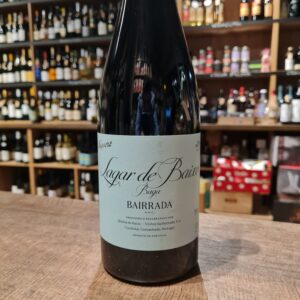 The huge passion of Dirk Niepoort for Baga variety and the fantastic terroir of the Bairrada region led him to look for small parcels of Baga in very old vines, scattered throughout the Cantanhede region, over the past three years. These wines were light in color and alcoholic content, elegant and fine, soon after bottling, but with a huge ageing potential. With the acquisition of the Quinta de Baixo in 2012, it became possible to recreate the Lagar de Baixo brand, moving towards a classically-styled wine which highlights the nobility of Baga grown in Bairrada. The red Lagar de Baixo is the result of a combination of very old vines and younger vines: complex, serious, but with some youth and grip. The 2020 Lagar de Baixo is our most classic wine from Quinta de Baixo and the wine that best reflects the Bairrada terroir. It is fermented in lagares and aged in used barrels. Food Suggestion: Venison dishes (partridge, wild boar), pork and bean stew, baked cod. Vegetarian suggestions: dishes with legumes (red kidney beans, lentils).
The huge passion of Dirk Niepoort for Baga variety and the fantastic terroir of the Bairrada region led him to look for small parcels of Baga in very old vines, scattered throughout the Cantanhede region, over the past three years. These wines were light in color and alcoholic content, elegant and fine, soon after bottling, but with a huge ageing potential. With the acquisition of the Quinta de Baixo in 2012, it became possible to recreate the Lagar de Baixo brand, moving towards a classically-styled wine which highlights the nobility of Baga grown in Bairrada. The red Lagar de Baixo is the result of a combination of very old vines and younger vines: complex, serious, but with some youth and grip. The 2020 Lagar de Baixo is our most classic wine from Quinta de Baixo and the wine that best reflects the Bairrada terroir. It is fermented in lagares and aged in used barrels. Food Suggestion: Venison dishes (partridge, wild boar), pork and bean stew, baked cod. Vegetarian suggestions: dishes with legumes (red kidney beans, lentils). -
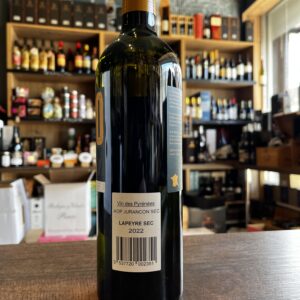
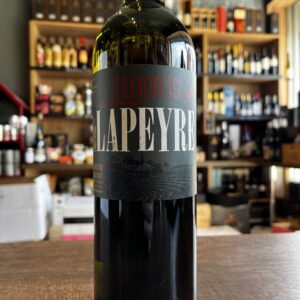 The Clos Lapeyere Estate is a family-owned estate that dealt with rearing livestock, cultivating vines and farming many years ago. It was in 1985 that the head of the family, Jean-Bernard Larrieu decided to exclusively focus on cultivating vines and making classic wines that spoke volumes about the richness of the Chapelle de Rousse appellation.
The Clos Lapeyere Estate is a family-owned estate that dealt with rearing livestock, cultivating vines and farming many years ago. It was in 1985 that the head of the family, Jean-Bernard Larrieu decided to exclusively focus on cultivating vines and making classic wines that spoke volumes about the richness of the Chapelle de Rousse appellation. -
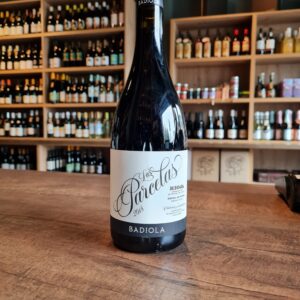 Bodega Badiola, was founded in 2018, part of the Peninsula Vinicultore Group when they bought an old company in the in Rioja Alavesa, the Basque region in the east and south east of Rioja. Their vineyards are situated on the slopes of the Sierra Cantabria, mostly tiny parcels the average size being only 0.3 hectares with an average vine age of 50 years but some of the vines are obviously significantly older. With respect for the environment, minimal spraying of copper and sulphur only are used, so all but Organic. The Las Parcelas comes from 300 carefully selected parcels of old bush Tempranillo vines planted in limestone soils, resulting in elegant wines that are fresh and age worthy due to the balancing acidity. The winemaking philosophy is to keep that purity and freshness by careful use of oak, giving a real point of difference to the traditional oaky Riojas. On the nose and palate, the fruit is very much to the fore with cherry and blackberry fruit with hints of spice and with fresh acidity and almost chalky tannins from that limestone soils. Though it is still young give it some air and it really blossoms, drinking significantly better at dinner rather than lunch when first opened, so will keep well too.
Bodega Badiola, was founded in 2018, part of the Peninsula Vinicultore Group when they bought an old company in the in Rioja Alavesa, the Basque region in the east and south east of Rioja. Their vineyards are situated on the slopes of the Sierra Cantabria, mostly tiny parcels the average size being only 0.3 hectares with an average vine age of 50 years but some of the vines are obviously significantly older. With respect for the environment, minimal spraying of copper and sulphur only are used, so all but Organic. The Las Parcelas comes from 300 carefully selected parcels of old bush Tempranillo vines planted in limestone soils, resulting in elegant wines that are fresh and age worthy due to the balancing acidity. The winemaking philosophy is to keep that purity and freshness by careful use of oak, giving a real point of difference to the traditional oaky Riojas. On the nose and palate, the fruit is very much to the fore with cherry and blackberry fruit with hints of spice and with fresh acidity and almost chalky tannins from that limestone soils. Though it is still young give it some air and it really blossoms, drinking significantly better at dinner rather than lunch when first opened, so will keep well too. -
Out of stock
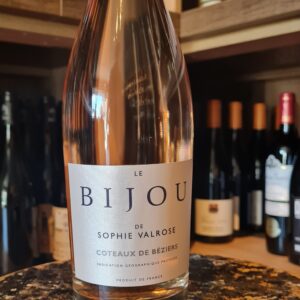 Le Bijou de Sophie Valrose is named after a lady who worked in the Languedoc vineyards during the late 19th century and became something of a local hero. At the time, it was largely women who worked in the vineyards; pruning and harvesting the vines. Sadly these women were often mistreated, overworked and underpaid. Sophie fought for women’s rights and drastically improved the conditions for her fellow female workers in the vineyard in which she worked. Bijou is a tribute to her memory and we share her story on the back of every bottle sold. The grapes are sourced from low-yielding old vines on the sloping hillsides of various vineyards in the Languedoc-Roussillon region of southern France. The areas are made up of old volcanic soils composed of 70% schist, which helps create high-quality grapes with great structure and freshness.Bijou’s flagship wine, a beautiful pale salmon coloured rosé. Elegantly fragrant, with aromas of wild strawberries, citrus and delicate floral notes. Round and creamy on the palate, with ripe red berry flavours and a soft minerality. Elegant and balanced with refreshing acidity and a silky smooth finish. The perfect accompaniment to canapés, white meats, fish and salads.
Le Bijou de Sophie Valrose is named after a lady who worked in the Languedoc vineyards during the late 19th century and became something of a local hero. At the time, it was largely women who worked in the vineyards; pruning and harvesting the vines. Sadly these women were often mistreated, overworked and underpaid. Sophie fought for women’s rights and drastically improved the conditions for her fellow female workers in the vineyard in which she worked. Bijou is a tribute to her memory and we share her story on the back of every bottle sold. The grapes are sourced from low-yielding old vines on the sloping hillsides of various vineyards in the Languedoc-Roussillon region of southern France. The areas are made up of old volcanic soils composed of 70% schist, which helps create high-quality grapes with great structure and freshness.Bijou’s flagship wine, a beautiful pale salmon coloured rosé. Elegantly fragrant, with aromas of wild strawberries, citrus and delicate floral notes. Round and creamy on the palate, with ripe red berry flavours and a soft minerality. Elegant and balanced with refreshing acidity and a silky smooth finish. The perfect accompaniment to canapés, white meats, fish and salads. -
Out of stock
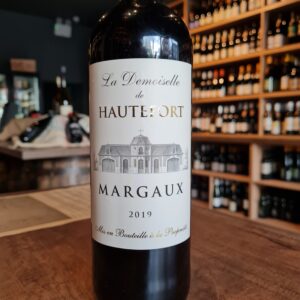 Slender and racy length, beautiful smoothness, noble freshness, very fragrant, without weakness in terms of the body and with the extension of high quality terroirs.
Slender and racy length, beautiful smoothness, noble freshness, very fragrant, without weakness in terms of the body and with the extension of high quality terroirs. -
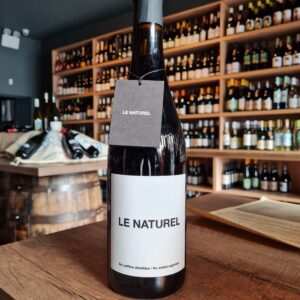 Le Naturel lives up to its name, it is a wine in which the Garnacha is expressed with great openness. On the nose aromas of blackberries and violets appear, while in the mouth it has a good attack of fresh fruit, typical of high altitude vineyards.It is a natural wine, without added sulfites, which also has the certificate of organic and vegan wine. With the aim of minimal intervention (in the field and in the winery) we found in Bodegas Aroa - Le Naturel a specimen of pure and enjoyable Grenache. Specially designed for consumption soon it is open and not for storage. Bodegas Aroa (Vintae group) is located in Zurucuáin, in the heart of the Yerri Valley , sheltered by the Urbasa and Andía Sierras. This winery is one of the pioneers in Navarra in its commitment to the recovery of organic farming practices .
Le Naturel lives up to its name, it is a wine in which the Garnacha is expressed with great openness. On the nose aromas of blackberries and violets appear, while in the mouth it has a good attack of fresh fruit, typical of high altitude vineyards.It is a natural wine, without added sulfites, which also has the certificate of organic and vegan wine. With the aim of minimal intervention (in the field and in the winery) we found in Bodegas Aroa - Le Naturel a specimen of pure and enjoyable Grenache. Specially designed for consumption soon it is open and not for storage. Bodegas Aroa (Vintae group) is located in Zurucuáin, in the heart of the Yerri Valley , sheltered by the Urbasa and Andía Sierras. This winery is one of the pioneers in Navarra in its commitment to the recovery of organic farming practices . -
 The Le Rime appears pale yellow with green highlights, with intense aromas of green fruit followed by zippy citrus on the nose. The palate is fresh and lively with ripe pear and juicy green apple in abundance, finishing clean and full with persistent fruit and citrus cream, particularly fetching but do not overchill and allow to open in the glass. Best consumed young and would be ideal with fresh fish and summer salads.
The Le Rime appears pale yellow with green highlights, with intense aromas of green fruit followed by zippy citrus on the nose. The palate is fresh and lively with ripe pear and juicy green apple in abundance, finishing clean and full with persistent fruit and citrus cream, particularly fetching but do not overchill and allow to open in the glass. Best consumed young and would be ideal with fresh fish and summer salads. -
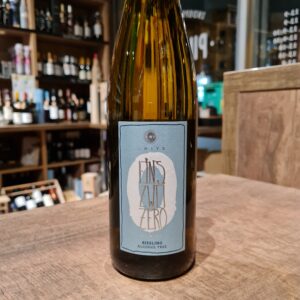 Johannes Leitz continues to innovate! In doing so, he recently partnered with a company to produce two alcohol-free rieslings. Germans have been producing non-alcoholic wines for over 70 years and that history has led to inventions to improve quality. Leitz’s hometown of Rüdesheim is the historic birthplace of the famous distillery Asbach Uralt. After the war, a fellow vigneron named Carl Jung began a distillery. Ultimately, Jung could not compete with the local brandy, but he developed a vacuum distillation system which enabled him to lower the temperature at which alcohol could boil off (because the boiling point decreases as atmospheric pressure decreases). Innovations in vacuum distillation have improved in recent years, and Leitz found a producer in Rheinhessen who recently patented a new, completely closed system that allows wine alcohol to boil at 28°C, preserving “wine-like” aromas and characteristics. As we all know, like fat, alcohol is a transporter of flavor, and without it, there needs to be something else to carry those flavors. 35 grams/L does the work for this riesling, though the sugar is nearly eaten up. Pairs well with gratinated crostini, cauliflower and goat’s cheese & butter, as well as with an Asian chicken casserole.
Johannes Leitz continues to innovate! In doing so, he recently partnered with a company to produce two alcohol-free rieslings. Germans have been producing non-alcoholic wines for over 70 years and that history has led to inventions to improve quality. Leitz’s hometown of Rüdesheim is the historic birthplace of the famous distillery Asbach Uralt. After the war, a fellow vigneron named Carl Jung began a distillery. Ultimately, Jung could not compete with the local brandy, but he developed a vacuum distillation system which enabled him to lower the temperature at which alcohol could boil off (because the boiling point decreases as atmospheric pressure decreases). Innovations in vacuum distillation have improved in recent years, and Leitz found a producer in Rheinhessen who recently patented a new, completely closed system that allows wine alcohol to boil at 28°C, preserving “wine-like” aromas and characteristics. As we all know, like fat, alcohol is a transporter of flavor, and without it, there needs to be something else to carry those flavors. 35 grams/L does the work for this riesling, though the sugar is nearly eaten up. Pairs well with gratinated crostini, cauliflower and goat’s cheese & butter, as well as with an Asian chicken casserole. -
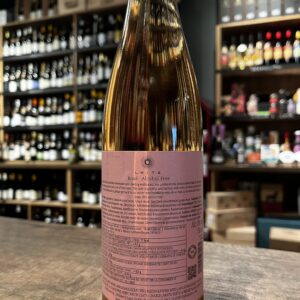
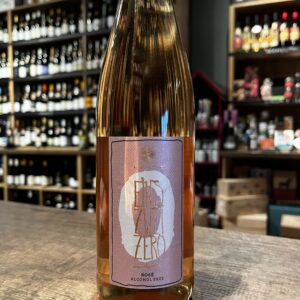 There are records linking the Leitz family to winemaking, dating all the way back to 1744. Johannes Leitz took over the winery in 1985 and since then has increased the estate from 2.9 hectares to the 40 hectares that we see today. He has always aimed to produce wines in an elegant style with pure fruitiness and great freshness, of the highest quality - and this includes his alcohol-free wines. Alcohol-free wine never will give the same depth, structure and weight as a wine with alcohol, but this is extremely close to it and it is simply an alcohol-free wine tasting wine. Impressive. We recommend to pair this wine with summer salads or different fruits.
There are records linking the Leitz family to winemaking, dating all the way back to 1744. Johannes Leitz took over the winery in 1985 and since then has increased the estate from 2.9 hectares to the 40 hectares that we see today. He has always aimed to produce wines in an elegant style with pure fruitiness and great freshness, of the highest quality - and this includes his alcohol-free wines. Alcohol-free wine never will give the same depth, structure and weight as a wine with alcohol, but this is extremely close to it and it is simply an alcohol-free wine tasting wine. Impressive. We recommend to pair this wine with summer salads or different fruits. -
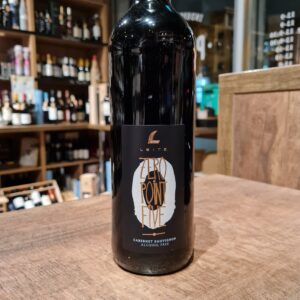 Eins-Zwei-Zero is a premium range of non-alcoholic wines created by award-winning winemaker Johannes Leitz. Using 100% Cabernet Sauvignon grapes from Argentina, these wines are produced with great attention to detail. The alcohol is removed through gentle vacuum distillation at low temperatures, allowing the natural flavours and delicate aromas to be preserved.
Eins-Zwei-Zero is a premium range of non-alcoholic wines created by award-winning winemaker Johannes Leitz. Using 100% Cabernet Sauvignon grapes from Argentina, these wines are produced with great attention to detail. The alcohol is removed through gentle vacuum distillation at low temperatures, allowing the natural flavours and delicate aromas to be preserved. -
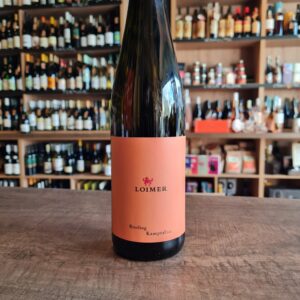 The Loimer estate is located around Langenlois in the sunny Kamptal region of Lower Austria, to the northwest of Vienna. Unlike many Austrian producers who go for a rich, sweet Alsace style, Fred Loimer obtains full ripeness in the vineyard yet ferments to dryness. The resulting wines (like the Loimer Riesling) display his trademark definition, zest and balance on the palate. Fred Loimer realised very early on that his future lay in wine, after his father converted the family farm into a winery. He attended Austria’s renowned Klosterneuburg University and later gained important experience at wineries in Nahe, Germany and in Napa Valley, California. On his return to Langenlois, Fred introduced new methods in the vineyards and winery, with the aim of continually improving the quality of the wine. In 1997, Fred took over the winery from his father and, in 1998, purchased and renovated a historical vaulted brick cellar (a former cellar of the Haindorf Castle) amidst the vines between Langenlois and Zöbing. The wines have been vinified and stored here since 1999. The 60 hectares of vineyards are divided into 100 parcels, planted on seven different soil types (ranging from loess, gravel, clay, sand and slate to Gföhler gneiss, a coarse-grained, metamorphic rock containing quartz, felspar and mica), which bring great complexity to the wines. There is no need to say that the high quality of their soils is crucial for the Loimer Riesling and its minerality. Situated at an altitude of 200-420m above sea level, the south facing vineyards benefit from warm days and cool nights, which encourage the development of the aromatic components in the grapes. The high summer temperatures are mitigated by the River Danube and the Waldviertel (forested area), while the well drained soils mean the vines can form deeply penetrating root systems, thus overcoming even long periods of drought without damage. Since 2006, the vineyard and cellar work has been conducted according to biodynamic principles.
The Loimer estate is located around Langenlois in the sunny Kamptal region of Lower Austria, to the northwest of Vienna. Unlike many Austrian producers who go for a rich, sweet Alsace style, Fred Loimer obtains full ripeness in the vineyard yet ferments to dryness. The resulting wines (like the Loimer Riesling) display his trademark definition, zest and balance on the palate. Fred Loimer realised very early on that his future lay in wine, after his father converted the family farm into a winery. He attended Austria’s renowned Klosterneuburg University and later gained important experience at wineries in Nahe, Germany and in Napa Valley, California. On his return to Langenlois, Fred introduced new methods in the vineyards and winery, with the aim of continually improving the quality of the wine. In 1997, Fred took over the winery from his father and, in 1998, purchased and renovated a historical vaulted brick cellar (a former cellar of the Haindorf Castle) amidst the vines between Langenlois and Zöbing. The wines have been vinified and stored here since 1999. The 60 hectares of vineyards are divided into 100 parcels, planted on seven different soil types (ranging from loess, gravel, clay, sand and slate to Gföhler gneiss, a coarse-grained, metamorphic rock containing quartz, felspar and mica), which bring great complexity to the wines. There is no need to say that the high quality of their soils is crucial for the Loimer Riesling and its minerality. Situated at an altitude of 200-420m above sea level, the south facing vineyards benefit from warm days and cool nights, which encourage the development of the aromatic components in the grapes. The high summer temperatures are mitigated by the River Danube and the Waldviertel (forested area), while the well drained soils mean the vines can form deeply penetrating root systems, thus overcoming even long periods of drought without damage. Since 2006, the vineyard and cellar work has been conducted according to biodynamic principles. -
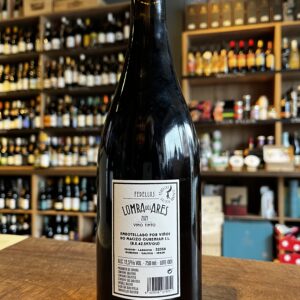
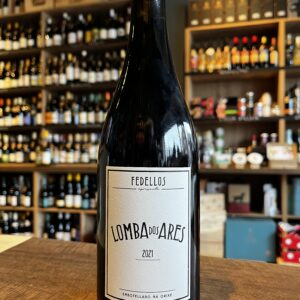 Lomba dos Ares is a Spanish take on Beaujolais, a blend of native grapes - Mencía, Mouratón, Garnacha Tintorera, Caiño and Bastardo - that captures the essence of Ribeira Sacra with a perfumed nose and plenty of freshness and finesse on the palate. It's not surprising that beautiful places like this produce soulful wines. Red fruits, orange peel, violets and cedar come in layers making this delicious to sip solo but also very versatile with charcuterie, roasted vegetable or pork dishes.
Lomba dos Ares is a Spanish take on Beaujolais, a blend of native grapes - Mencía, Mouratón, Garnacha Tintorera, Caiño and Bastardo - that captures the essence of Ribeira Sacra with a perfumed nose and plenty of freshness and finesse on the palate. It's not surprising that beautiful places like this produce soulful wines. Red fruits, orange peel, violets and cedar come in layers making this delicious to sip solo but also very versatile with charcuterie, roasted vegetable or pork dishes. -
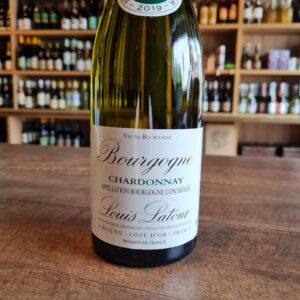 The result of a long history, Burgundy and its wines are known worldwide. Chardonnay being a native grape to the area, perfectly matches the terroir of Burgundy: poor soils or calcareous marl, perfect exposure but a temperate climate. As a result the sugar content can reach a high level whilst maintaining a balance of fruit and acidity. Thanks to a careful selection, Maison Louis Latour is able to produce a rich and expressive Chardonnay. This wine is intense, powerful and fruity. A complexe wine with a nice aromatic persistence. Food Pairing, aperitif - shellfish - charcuterie - grilled fish
The result of a long history, Burgundy and its wines are known worldwide. Chardonnay being a native grape to the area, perfectly matches the terroir of Burgundy: poor soils or calcareous marl, perfect exposure but a temperate climate. As a result the sugar content can reach a high level whilst maintaining a balance of fruit and acidity. Thanks to a careful selection, Maison Louis Latour is able to produce a rich and expressive Chardonnay. This wine is intense, powerful and fruity. A complexe wine with a nice aromatic persistence. Food Pairing, aperitif - shellfish - charcuterie - grilled fish -
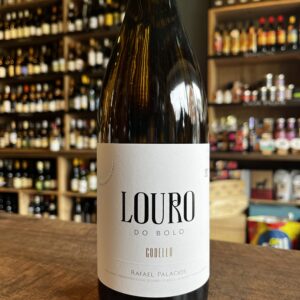 The best white wines of Spain are made of Godello from the region Valdeorras in Galicia. More and more this wine is can be seen in many wine lists across Ireland as its increasing popularity is par to the Albarino from Rias baixas or the Rueda's Verdejo. Rafael Palacios the maker of this wine comes from something of a winemaking dynasty. His father, uncle and brother are all highly regarded winemakers across Rioja, Priorat and other parts of the country. Rafael himself cut his teeth working on his father's Rioja estate, prior to training and working in Bordeaux and Coonawarra, South Australia. Rafa started this project in 2004 in the then little known region of Valdeorras, home of a few ancient plots of Godello vines. This grape variety was virtually extinct in Spain but Rafa and a few others realised its potential and extensive replanting of the variety began. The Louro is crafted from younger vines but is selected from plots that produce more age-worthy wines. Fermented with indigenous yeast and aged in used foudre, Louro showcases Rafa’s talent at balancing the minerality of the grape with the richness and texture of the élevage. Pair it with baked whitefish, bluefish, fish and vegetables, grilled fish, grilled whitefish, pasta with fish, poultry, rice with fish, roasted fish, roasted foods.
The best white wines of Spain are made of Godello from the region Valdeorras in Galicia. More and more this wine is can be seen in many wine lists across Ireland as its increasing popularity is par to the Albarino from Rias baixas or the Rueda's Verdejo. Rafael Palacios the maker of this wine comes from something of a winemaking dynasty. His father, uncle and brother are all highly regarded winemakers across Rioja, Priorat and other parts of the country. Rafael himself cut his teeth working on his father's Rioja estate, prior to training and working in Bordeaux and Coonawarra, South Australia. Rafa started this project in 2004 in the then little known region of Valdeorras, home of a few ancient plots of Godello vines. This grape variety was virtually extinct in Spain but Rafa and a few others realised its potential and extensive replanting of the variety began. The Louro is crafted from younger vines but is selected from plots that produce more age-worthy wines. Fermented with indigenous yeast and aged in used foudre, Louro showcases Rafa’s talent at balancing the minerality of the grape with the richness and texture of the élevage. Pair it with baked whitefish, bluefish, fish and vegetables, grilled fish, grilled whitefish, pasta with fish, poultry, rice with fish, roasted fish, roasted foods. -
 These fresh and lovely whites were carefully chosen to make you travel through different parts of the world in comfort with a glass in hand. These are fresh, light, crispy, open wines that are super delicious and will test your taste buds and impress. Ferdinand Mayr Grüner Veltliner- Ferdinand Mayr is a musician turned winemaker and his organic wines are singing with flavour and intensity. Whoever says Grüner Veltliner says Austria and vice versa. This version of Ferdinand Mayr is accessible and it charms you right away. Exuberant, lively nose of citrus, apple and white pepper. On the palate, the ripe fruit and spiciness create a pleasant tension with the acidity. Crispy and ripe, as if you were biting into a juicy apple. Flavor and spiciness characterize this wine. Fantastic with Japanese or Thai cuisine. Portuga White Lisboa- A wine that presents itself as modern, with excellent aromatic intensity and offering citric fruit notes. With a light body, it has also a great natural freshness and shows great balance in the aftertaste. Antonio Rubini Pinot Grigio delle Venezie- Italian Pinot Grigio through and through with no surprises. This wine shows apple and pear with hints of white peach and elderflower. Light and refreshing, a mouth-watering partner for salads and seafood. Great any day of the week. Les Chaises Sauvignon Blanc- Another one that won't disappoint. This is a Languedoc Roussillon white made for the locals in South West France. Delicious, fresh zesty lemon and green apple flavours, lively and refreshing with good length. Ideal as an aperitif, with seafood, white meats, goats cheese and salads. Marlborough Sun Sauvignon Blanc- This absolutely stunning New Zealand white is what you expect from a sauvignon blanc from Marlborough and more. The inspiration for the labels came from a newspaper article about an unusual phenomenon that has swept the region... Pioneri Mundi Albariño- If you are a fan of Spanish Albariños, this one just ticks the box. Fantastic, all rounder and easy to drink, perfect for any occasion. Compliments all sorts of food, especially Tapas.
These fresh and lovely whites were carefully chosen to make you travel through different parts of the world in comfort with a glass in hand. These are fresh, light, crispy, open wines that are super delicious and will test your taste buds and impress. Ferdinand Mayr Grüner Veltliner- Ferdinand Mayr is a musician turned winemaker and his organic wines are singing with flavour and intensity. Whoever says Grüner Veltliner says Austria and vice versa. This version of Ferdinand Mayr is accessible and it charms you right away. Exuberant, lively nose of citrus, apple and white pepper. On the palate, the ripe fruit and spiciness create a pleasant tension with the acidity. Crispy and ripe, as if you were biting into a juicy apple. Flavor and spiciness characterize this wine. Fantastic with Japanese or Thai cuisine. Portuga White Lisboa- A wine that presents itself as modern, with excellent aromatic intensity and offering citric fruit notes. With a light body, it has also a great natural freshness and shows great balance in the aftertaste. Antonio Rubini Pinot Grigio delle Venezie- Italian Pinot Grigio through and through with no surprises. This wine shows apple and pear with hints of white peach and elderflower. Light and refreshing, a mouth-watering partner for salads and seafood. Great any day of the week. Les Chaises Sauvignon Blanc- Another one that won't disappoint. This is a Languedoc Roussillon white made for the locals in South West France. Delicious, fresh zesty lemon and green apple flavours, lively and refreshing with good length. Ideal as an aperitif, with seafood, white meats, goats cheese and salads. Marlborough Sun Sauvignon Blanc- This absolutely stunning New Zealand white is what you expect from a sauvignon blanc from Marlborough and more. The inspiration for the labels came from a newspaper article about an unusual phenomenon that has swept the region... Pioneri Mundi Albariño- If you are a fan of Spanish Albariños, this one just ticks the box. Fantastic, all rounder and easy to drink, perfect for any occasion. Compliments all sorts of food, especially Tapas. -
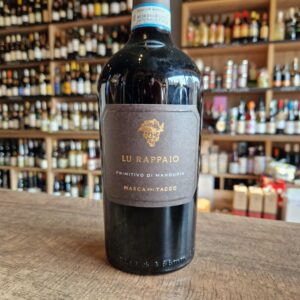 Primitivo is practically synonymous with Puglia and the south of Italy. If you truly want to experience the quality of a fine Primitivo di Manduria, try this wine. It must be said that the Primitivo di Manduria is slightly different from the rest of Puglia. Manduria has a privileged location, right in the middle of the Salento peninsula.This allows the marine breeze coming from both the Adriatic Sea and the Ionian Sea to refresh the vineyard. The soil is composed of limestone with iron oxide fossils, giving it a distinctive red color. This soil is also known as Terra Rossa and it is typical of the Mediterranean region.The climate is ideal too, with mild winters and extremely hot summers and according to Decanter, "Primitivo is the most sun-loving grape I have seen." It goes well with dark and white meat from the grill or from the oven. Also a pleasant red wine with pasta dishes with spicy sauces as well as spicy cheeses. Its elegance and structure make it a perfect wine for romantic evenings or important dinners
Primitivo is practically synonymous with Puglia and the south of Italy. If you truly want to experience the quality of a fine Primitivo di Manduria, try this wine. It must be said that the Primitivo di Manduria is slightly different from the rest of Puglia. Manduria has a privileged location, right in the middle of the Salento peninsula.This allows the marine breeze coming from both the Adriatic Sea and the Ionian Sea to refresh the vineyard. The soil is composed of limestone with iron oxide fossils, giving it a distinctive red color. This soil is also known as Terra Rossa and it is typical of the Mediterranean region.The climate is ideal too, with mild winters and extremely hot summers and according to Decanter, "Primitivo is the most sun-loving grape I have seen." It goes well with dark and white meat from the grill or from the oven. Also a pleasant red wine with pasta dishes with spicy sauces as well as spicy cheeses. Its elegance and structure make it a perfect wine for romantic evenings or important dinners -
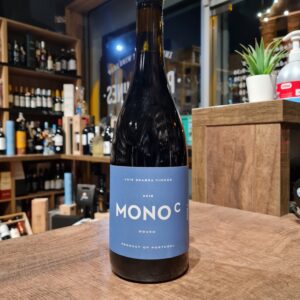 Luis Seabra is a producer that is at the forefront of the “new Douro” movement. Rather than making table wines that are, for all intents and purposes, “Little Ports,” Luis has taken a more balanced, restrained approach to winemaking in the oldest demarcated wine region in the world. His guiding principles are showcasing terroir and nuance above power and extraction. Bright, mineral driven and elegant, Luis’ wines are typically exposés of soil type. With the Mono C, he is taking a look at a particular variety – in this case, Castelão. While Castelão is a grape that is typically found further south in Portugal, Luis has found a mono-planted plot of the light-skinned grape in the Douro and is working his magic to craft a wine of unparalleled delicacy and elegance. Would pair it with charcuterie, grilled pork dishes, roasted poultry
Luis Seabra is a producer that is at the forefront of the “new Douro” movement. Rather than making table wines that are, for all intents and purposes, “Little Ports,” Luis has taken a more balanced, restrained approach to winemaking in the oldest demarcated wine region in the world. His guiding principles are showcasing terroir and nuance above power and extraction. Bright, mineral driven and elegant, Luis’ wines are typically exposés of soil type. With the Mono C, he is taking a look at a particular variety – in this case, Castelão. While Castelão is a grape that is typically found further south in Portugal, Luis has found a mono-planted plot of the light-skinned grape in the Douro and is working his magic to craft a wine of unparalleled delicacy and elegance. Would pair it with charcuterie, grilled pork dishes, roasted poultry -
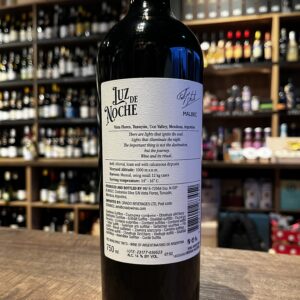
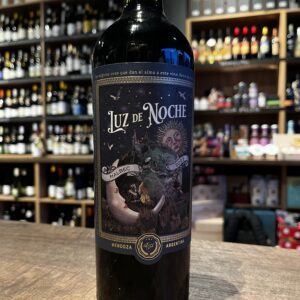 The revered Argentinian musician-Filipe Staiti- and owner of this beautiful winery situated in the Iconic wine region Tupungato-Mendoza told me to add the following to wine page: There are lights that ignite the soul. Lights that illuminate the night. The important thing is not the destination, but the journey. Wine and its ritual... Sounds better in Spanish, trust me! As for the wine In case you didn't know Luz de Noche translates to english as “Light of the Night”. In fact, harvest takes place during the night in the month of March, hence really the name of wine. Ideal for pasta with tomato or Bolognese sauce, pizza and meats
The revered Argentinian musician-Filipe Staiti- and owner of this beautiful winery situated in the Iconic wine region Tupungato-Mendoza told me to add the following to wine page: There are lights that ignite the soul. Lights that illuminate the night. The important thing is not the destination, but the journey. Wine and its ritual... Sounds better in Spanish, trust me! As for the wine In case you didn't know Luz de Noche translates to english as “Light of the Night”. In fact, harvest takes place during the night in the month of March, hence really the name of wine. Ideal for pasta with tomato or Bolognese sauce, pizza and meats -
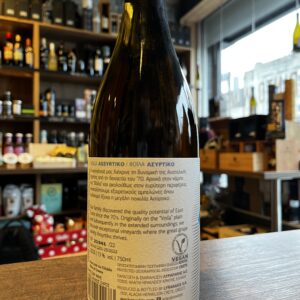
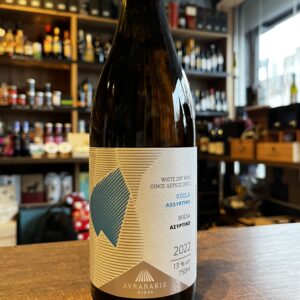 Anyone that has been to Greece or has interest in wines have come by the grape Assyrtiko . In the last few years, wines from Greece, in particularly this indigenous grape, have gotten the status as a world-class wine and prices have begun to rise especially from the Santorini region. This Vegan Assyrtiko from the Lyrarakis estate is one of them and it is still in the affordable range and fortunately, your everyday Assyrtiko needs can still be catered for. Being from east Crete rather than Santorini means prices are still competitive. Think down the lines of getting a wine from the Touraine region rather than the heart of the Loire Valley. Lyrarakis on Crete are a brilliant winery with a focus on indigenous Greek varieties. Their rendition of Assyrtiko is broader and more approachable than some of the tightly-wound examples on Santorini, but it's no less drinkable for that. It is in fact an ideal place to grow the white grape Assyrtiko. Both the Mediterranean breezes and the altitude of the Lyrarakis vineyards allows the grapes to have a much longer ripening period, preserving the grapes aromatics and acidity resulting in a wine with wonderful floral freshness, crisp citrus notes and a delicate mineral finish. Yamas!
Anyone that has been to Greece or has interest in wines have come by the grape Assyrtiko . In the last few years, wines from Greece, in particularly this indigenous grape, have gotten the status as a world-class wine and prices have begun to rise especially from the Santorini region. This Vegan Assyrtiko from the Lyrarakis estate is one of them and it is still in the affordable range and fortunately, your everyday Assyrtiko needs can still be catered for. Being from east Crete rather than Santorini means prices are still competitive. Think down the lines of getting a wine from the Touraine region rather than the heart of the Loire Valley. Lyrarakis on Crete are a brilliant winery with a focus on indigenous Greek varieties. Their rendition of Assyrtiko is broader and more approachable than some of the tightly-wound examples on Santorini, but it's no less drinkable for that. It is in fact an ideal place to grow the white grape Assyrtiko. Both the Mediterranean breezes and the altitude of the Lyrarakis vineyards allows the grapes to have a much longer ripening period, preserving the grapes aromatics and acidity resulting in a wine with wonderful floral freshness, crisp citrus notes and a delicate mineral finish. Yamas!


